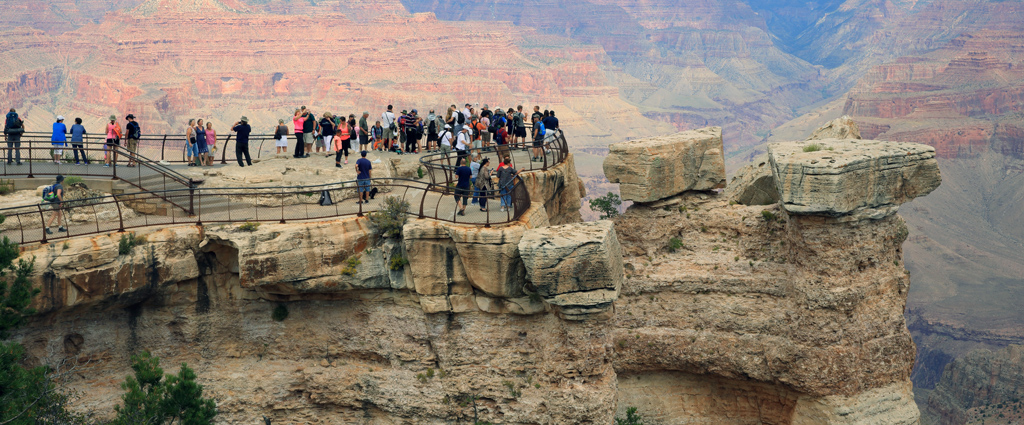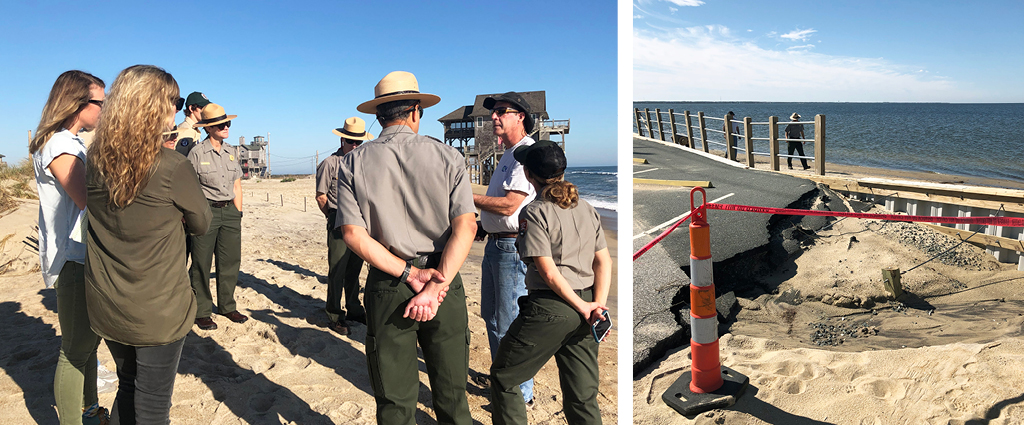Forward-thinking insights focused on a more sustainable tomorrow.
Enhanced Visitor Experience: Lessons from the National Park Service To Remain Resilient
The National Park Service (NPS) has witnessed an unprecedented surge in visitors to parks across the country in recent years. This trend has been driven by a variety of factors, including the Covid-19 pandemic, social media, and international tourism. Visitors are drawn to national parks for their awe-inspiring landscapes, rich history and culture, opportunities for peace and quiet, adventure and recreation, and connection with nature. In fact, according to NPS, 44 national parks set a record for the highest number of recreation visits ever recorded in 2021, and 12 national parks achieved the same feat in 2022.
While this increase in tourism is exciting, it also presents challenges for the visitor experience and resource management. Overcrowding, long lines, and limited services and resources can strain environmental resources, wildlife, infrastructure, and traffic management. As the number of visitors continues to rise, NPS is committed to enhancing visitor experiences and preserving each park’s ecological integrity. To do this, NPS, along with other federal land management agencies, follow the Interagency Visitor Use Management Council’s (IVUMC) Visitor Use Management Framework. The IVUMC process is future-focused and proactive, defining goals and objectives, desired conditions, management strategies and actions, and implementation and monitoring. By understanding their visitors and what’s important to them, NPS can prioritize projects, allocate funding, assess potential impacts to the environment, and identify additional safety needs.

Data-Informed Decisions Are Better Decisions
As individual parks strive to decrease the impacts of overcrowding, innovative solutions and a collaborative approach are important for navigating the complex desires between all stakeholders. Before planning can even begin, data is an important tool to provide quantifiable information that helps inform patterns, trends, and correlations between behavior. By incorporating study outcomes with staff observations and experiences, it results in strategies that inform decision-making and guide planning.
As part of a study to evaluate new traffic data collection technology at four federal land sites, NPS and the Federal Highway Administration (FHWA) sought to understand visitor use patterns in more remote areas—where visitors were traveling, their passage from one destination to the next, length of time spent at each destination, camping information, and points of concentration. With federal park lands being in some of the most remote areas, it was important for NPS to understand where these visitors were traveling so that they could be proactive about enhanced service offerings and positive experiences, while confirming that sites remain protected for enjoyment well into the future. To analyze these factors in depth, new technologies were studied beyond traditional data collection methods to help inform planning and management strategies.

The four federal land sites evaluated in the study are popular park sites and collecting data is complex. VHB’s technology team partnered with NPS to test new methods for data collection to measure visitor travel and duration of stay patterns more accurately in remote areas. The study tested different technology for behavior patterns and travel trends that is challenging to capture with traditional data collection methods, such as surveys and
traffic counts.
NPS wanted to understand this information to improve planning for congestion mitigation, site traffic operations, parking demands, and visitor use management. The use of data is helpful for enhancing decision making, optimizing operational strategies, and protecting assets. This information not only helps NPS but is also beneficial for prospective sightseers in comprehending and planning their trip—understanding what lies in store prior to even stepping foot on park lands. Visitor use management provides insight into anticipated scenarios, such as potential congestion and alternative routes, parking statuses and additional options if lots are full, campsite availability, and ideal times to hike to avoid long lines.
A Framework Provides Clarity
Arches National Park (ARCH), located in the scenic Moab region of Utah, has seen a remarkable increase in visitors over the past decade. During its peak season of April through October, the park’s popularity has led to some challenges, including long lines waiting to enter the park. In fact, the park’s entrance has had to be temporarily closed more than 120 times in a single summer due to high levels of visitor use. In addition to these challenges, ARCH has also been grappling with limited parking at key locations such as the Visitor’s Center and popular trailheads.
A time-lapse video shows visitors at the end of the hike to Delicate Arch, the largest free-standing arch in Arches National Park that attracts more than 1.5 million visitors a year.
NPS initiated a pre-National Environmental Policy Act (NEPA) study for ARCH, with more than 10 years of data collection, to evaluate the environmental impacts of multiple alternatives that would enhance the visitor experience, like addressing congestion, parking availability, protection of sensitive resources, and facility overuse. VHB assisted NPS with the pre-NEPA process to inform all stakeholders, identify what is truly important, and begin to document the decision-making process.
This is a great example of how a process, like NEPA, can be useful for visitor use management because it helps define and identify priorities for stakeholders and potential environmental impacts. It’s also an approach that provides an opportunity to gain input—what are the things they care about, how do they use the space or amenity, and what would they like to see in the future? For ARCH, NPS was faced with the challenge of overcrowding. Through the pre-NEPA process, they were able to begin evaluating potential alternatives to address that challenge, such as a shuttle system, timed entry reservations, and site-specific reservations.
In April 2022, NPS piloted their first timed ticket entry system at ARCH for private vehicles. The goal for the timed ticket entry system is to reduce congestion and spread visitation out across various times of day, days of the month, and months of the year. NPS is currently further analyzing this approach through the NEPA process to determine if it’s an effective permanent solution.
A Long-Term Mindset Protects Assets for Future Generations
Visitor use management also includes balancing each park’s ecological integrity, an imperative approach when it comes to preserving and safeguarding the natural and cultural resources found within national parks. Only through a steadfast commitment to long-term planning can we provide the resilience of such sites and the protection of their fundamental resources and values for years to come. NPS has been taking a long-term approach to addressing challenges at Cape Hatteras National Seashore (the Seashore), a popular tourist destination in the Outer Banks, NC. A 20-year Sediment Management Framework and Environmental Impact Statement (EIS) as well as rehabilitation of the Cape Hatteras Light Station were developed in partnership with VHB to mitigate potential impacts and protect this dynamic landscape as it faces future challenges from both rising sea levels and rising visitation levels.
Instead of focusing on short-term gains or immediate visitor satisfaction, the Sediment Management Framework provides a long-term guide for timely special use permit issuance for actions such as beach nourishment, habitat restoration, and dune restoration along the Seashore. This long-term planning approach will help prevent degradation and make certain that accessibility and availability for visitors and residents well into the future. By having a comprehensive understanding of all sediment management activities that occur, NPS is putting measures in place to help minimize impacts over time and maintain the overall ecological health of the area.

The restoration efforts at the Cape Hatteras Light Station, led by Quinn Evans Architects, include VHB providing optimizations to pedestrian circulation throughout the site to help the lighthouse remain functional for years to come. Clearly marked pathways and wayfinding will also be implemented to minimize congestion on crowded days, create points of interest, and guide visitors to key attractions. The existing site is experiencing degradation of the landscape, and the new circulation pattern will better accommodate large crowds during peak tourist seasons, creating a more positive experience for all to enjoy.
This future-focused mindset to visitor use management addresses infrastructure needs, tourism growth, and disaster management, incorporating studies and data to address existing concerns and emerging issues.
How VHB Can Help
With an integrated, holistic approach to each project, VHB is creating spaces and shaping communities with prosperous outcomes. Whether planning for infrastructure improvements, a sitewide resiliency plan, bicycle and pedestrian facility, or new trail, these lessons from NPS on visitor behavior are helpful to learn from to create outcomes that promote well-being, repeat users, ease of maintenance, and positive publicity. How these challenges are solved helps build a strong foundation, making communities resilient and ready for what’s to come.
We work with agencies across all markets—utilizing these same techniques to proactively address concerns and emerging issues. We partner to help vet improvements through technology-enabled consulting, using data and feedback from the public so that the goals and parameters of a project are clearer when it’s ready to move forward to implementation. We help prioritize projects while balancing sustainability, resiliency, known fiscal restraints, and various stakeholder input.
Learn more about how VHB partners with the federal government, including NPS, to deliver creative, practical solutions for an improved visitor experience. Connect with our Senior Environmental Planner Jennifer Morrissey, or Director of Technology PMO, Application Development Taruna Tayal to start planning for a future-focused tomorrow.




